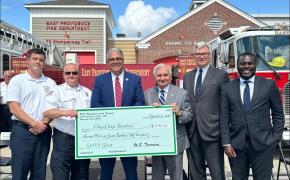FOR IMMEDIATE RELEASE
August 2, 2024
CONTACT INFO.:
Captain John H. Potvin
Dir. of Emergency Medical Services
(401) 639-0762
jpotvin@eastprovidenceri.gov
East Providence Fire Department nationally recognized for its commitment to quality care for heart attacks and strokes in Rhode Island
The American Heart Association presents the Mission: Lifeline® - EMS GOLD with Target: Heart Attack Honor Roll achievement award for proven dedication to best practices and life-saving care.
EAST PROVIDENCE, RI – The East Providence Fire Department has received the American Heart Association’s Mission: Lifeline® EMS– GOLD with Target: Heart Attack Honor Roll achievement award for its commitment to offering rapid and research-based care to people experiencing the most severe form of heart attacks and strokes, ultimately saving lives.
Emergency medical services staff can begin treatment when they arrive — up to an hour sooner than if someone goes to the hospital by car. EMS staff are also trained to provide resuscitation efforts to someone whose heart has stopped. People who arrive by ambulance may also receive
faster treatment at the hospital.
Mission: Lifeline EMS® is the American Heart Association's national initiative to advance the system of care for patients with high-risk, time-sensitive disease states, such as severe heart attacks and strokes. The program helps reduce barriers to prompt treatment — starting from when 911 is called, to EMS transport and continuing through hospital treatment and discharge. Optimal care for heart attack and stroke patients takes coordination between the individual prehospital providers and healthcare systems.
“Arguably the most important link in the chains of survival for acute stroke and cardiovascular emergencies is emergency medical services and prehospital professionals,” said Edward Jauch, M.D., MS, MBA, chair of the department of research at the University of North Carolina Health Sciences at Mountain Area Health Center. “Early condition identification, stabilization and prehospital interventions, and initiation of actions within the regional systems of care provide patients with the best chance for receiving expedient definitive therapies leading to optimal
outcomes and maximized quality of life.
“The American Heart Association Mission: Lifeline EMS awards are an important way to recognize the crucial roles and performances of EMS personnel in stroke and cardiac patients’ care.” The Mission: Lifeline EMS achievement award focuses on agencies’ on-scene care, bringing to the forefront the collaboration and contributions to patient care for prehospital providers. “The East Providence Fire Department is honored to be recognized by the American Heart Association for our dedication to providing optimal care for heart attack patients,” said Director of Emergency Medical Services Capt. John Potvin “The Mission: Lifeline program puts proven knowledge and guidelines to work on a daily basis, so patients have the best possible chance of survival.”
The East Providence Fire Department is also recognized on the American Heart Association’s Mission: Lifeline System of Care Target Heart Attack Honor Roll achievement award, focused on the system of care for patients. This award highlights the collaboration and contributions of both
prehospital and hospital providers. This time-critical award level is limited to those agencies that provide patient transport to STEMI-receiving and STEMI-referring centers.
About Mission: Lifeline Mission: Lifeline EMS® recognition is the American Heart Association’s program that recognizes prehospital emergency agencies for their quality of care for heart attack and stroke patients. The recognition program focuses on transforming care quality by
connecting all heart attack and stroke care components into a seamlessly integrated care system. Key tenets of these systems of care reinforce evidence-based guidelines and measure performance, identify gaps, and engage in quality improvement.
For more information, visit heart.org





